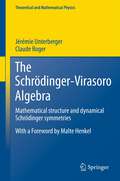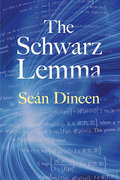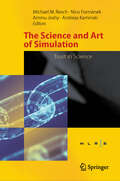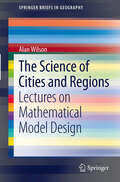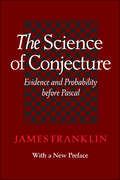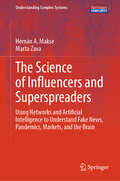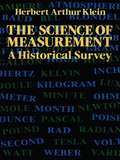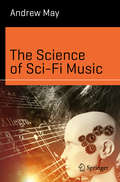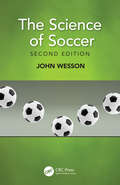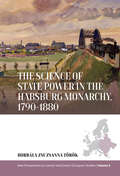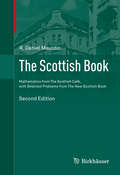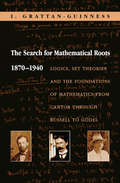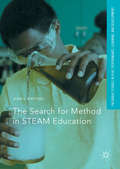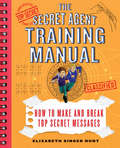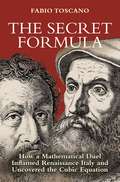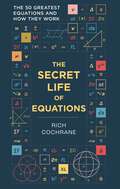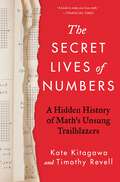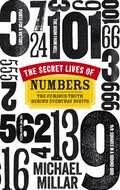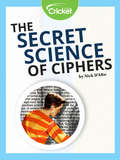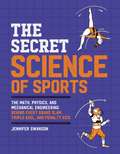- Table View
- List View
The Schrödinger-Virasoro Algebra
by Claude Roger Jérémie UnterbergerThis monograph provides the first up-to-date and self-contained presentation of a recently discovered mathematical structure--the Schrödinger-Virasoro algebra. Just as Poincaré invariance or conformal (Virasoro) invariance play a key rôle in understanding, respectively, elementary particles and two-dimensional equilibrium statistical physics, this algebra of non-relativistic conformal symmetries may be expected to apply itself naturally to the study of some models of non-equilibrium statistical physics, or more specifically in the context of recent developments related to the non-relativistic AdS/CFT correspondence. The study of the structure of this infinite-dimensional Lie algebra touches upon topics as various as statistical physics, vertex algebras, Poisson geometry, integrable systems and supergeometry as well as representation theory, the cohomology of infinite-dimensional Lie algebras, and the spectral theory of Schrödinger operators.
The Schwarz Lemma (Dover Books on Mathematics)
by Sean DineenThe Schwarz lemma is among the simplest results in complex analysis that capture the rigidity of holomorphic functions. This self-contained volume provides a thorough overview of the subject; it assumes no knowledge of intrinsic metrics and aims for the main results, introducing notation, secondary concepts, and techniques as necessary. Suitable for advanced undergraduates and graduate students of mathematics, the two-part treatment covers basic theory and applications. Starting with an exploration of the subject in terms of holomorphic and subharmonic functions, the treatment proves a Schwarz lemma for plurisubharmonic functions and discusses the basic properties of the Poincaré distance and the Schwarz-Pick systems of pseudodistances. Additional topics include hyperbolic manifolds, special domains, pseudometrics defined using the (complex) Green function, holomorphic curvature, and the algebraic metric of Harris. The second part explores fixed point theorems and the analytic Radon-Nikodym property.
The Science Girls
by AkiGrab your goggles and join the Science Girls! We’re science girls! We love to learn.We gather, test, assess, discern!From the lab to the meadow to the greenhouse—the science girls have lots to see, lots to do, and lots to explore. Follow this troupe of busy girls as they have fun hypothesizing and analyzing in a day full of curiosity and excitement.
The Science and Art of Simulation: Trust in Science
by Michael M. Resch Andreas Kaminski Nico Formánek Ammu JoshyTrust is a central pillar of the scientific enterprise. Much work in the philosophy of science can be seen as coping with the problem of establishing trust in a certain theory, a certain model, or even science as a whole. However, trust in science is threatened by various developments. With the advent of more complex models and the increasing usage of computer methods such as machine learning and computer simulation, it seems increasingly challenging to establish trust in science. How and on what basis can an appropriate trust in science be built? We are interested in how trust is established in such cases of increasing complexity (of models and communication) and what could be appropriate measures to alleviate doubt.
The Science of Cities and Regions: Lectures on Mathematical Model Design
by Alan WilsonA 'science of cities and regions' is critical for meeting future challenges. The world is urbanising: huge cities are being created and are continuing to grow rapidly. There are many planning and development issues arising in different manifestations in countries across the globe. These developments can, in principle, be simulated through mathematical computer models which provide tools for forecasting and testing future scenarios and plans. These models can represent the functioning of cities and regions, predicting the spatial demography and the economy, the main flows such as journey to work or to services, and the mechanisms of future evolution. In this book, the main principles involved in the design of this range of models are articulated, providing an account of the current state of the art as well as future research challenges. Alan Wilson has over forty years working with urban and regional models and has contributed important discoveries. He has distilled this experience into what serves as both an introduction and a review of the research frontier. Topics covered include the Lowry model, the retail model, principles of account-based models and the methods rooted in Boltzmann-style statistical modelling and the Lotka-Volterra approach to system evolution. Applications range from urban and regional planning to wars and epidemics.
The Science of Conjecture: Evidence and Probability before Pascal
by James FranklinHow did we make reliable predictions before Pascal and Fermat's discovery of the mathematics of probability in 1654? What methods in law, science, commerce, philosophy, and logic helped us to get at the truth in cases where certainty was not attainable? In The Science of Conjecture, James Franklin examines how judges, witch inquisitors, and juries evaluated evidence; how scientists weighed reasons for and against scientific theories; and how merchants counted shipwrecks to determine insurance rates.The Science of Conjecture provides a history of rational methods of dealing with uncertainty and explores the coming to consciousness of the human understanding of risk.
The Science of Influencers and Superspreaders: Using Networks and Artificial Intelligence to Understand Fake News, Pandemics, Markets, and the Brain (Understanding Complex Systems)
by Hernán A. Makse Marta ZavaThis book explores the identification of influencers in complex networks, bridging theoretical approaches with practical applications across diverse fields. It examines interdisciplinary complex systems, including online social media, biological networks, brain networks, socioeconomic and financial systems, and ecosystems. The research presented aims to benefit scientists in relevant areas and inspire new scientific inquiries, potentially advancing the field of influencer identification. In this context, 'influencer' serves as an umbrella term for essential, core, or central nodes within any complex network. The book investigates various manifestations of influencers, such as key figures in social media, critical nodes in genetic and brain networks, keystone species in ecosystems, systemically important banks in financial markets, and disease superspreaders. These diverse scenarios are approached by mapping the influencer identification problem to challenges in physics or computer science. The book caters to readers at three distinct levels: 1. Those seeking mathematically rigorous theories of influencers will find Chapter 2 particularly valuable, as it delves into the mathematical foundations of influencer identification algorithms. Subsequent chapters explore the application of these theories across various disciplines. 2. Data scientists interested in implementing these algorithms in their research and practical work will find relevant information throughout the book. 3. Professionals in finance, marketing, politics, and social media, as well as readers curious about the intersection of big data, influencers, and AI, will gain insights into how these tools can enhance decision-making processes. These readers are encouraged to focus on the introduction and chapters most relevant to their fields, while briefly reviewing the more technical sections. By offering this multi-layered approach, the book aims to provide a comprehensive understanding of influencer identification in complex networks, from theoretical foundations to real-world applications across various domains.
The Science of Measurement: A Historical Survey
by Herbert Arthur Klein"Klein is both a skilled reporter and a wide-ranging humanistic scholar. The book is popular and learned, witty and serious, literary and mathematical -- always solid and entertaining." -- Los Angeles Times.Although the topic of measurement might seem to lend itself to a dry-as-dust treatment, this book is just the opposite: an engrossing, easy-to-read study that treats a multifaceted topic with wit, imagination, and wide-ranging scholarship.Metrology, the science of measurement, usually concerns itself with length, weight, volume, temperature, and time, but in this comprehensive work the topic also encompasses nuclear radiation, thermal power, light, pressure, sound, and many other areas. Representing nearly ten years of research effort, The Science of Measurement is considered a definitive book on the concepts and units by which we measure everything in our universe. Nontechnical in its approach, it is not only completely accessible to the general reader but as entertaining and fun to read as it is informative and comprehensive. " . . . not concerned only with problems of measuring the limits of space or the size of the proton. It is filled with interesting digressions. Not a book for daydreaming, but a book for the curious. Klein's survey of the units and concepts by which we measure everything in the universe helps us understand that universe much better." -- Boston Herald Advertiser
The Science of Sci-Fi Music (Science and Fiction)
by Andrew MayThe 20th century saw radical changes in the way serious music is composed and produced, including the advent of electronic instruments and novel compositional methods such as serialism and stochastic music. Unlike previous artistic revolutions, this one took its cues from the world of science. Creating electronic sounds, in the early days, required a well-equipped laboratory and an understanding of acoustic theory. Composition became increasingly “algorithmic”, with many composers embracing the mathematics of set theory. The result was some of the most intellectually challenging music ever written – yet also some of the best known, thanks to its rapid assimilation into sci-fi movies and TV shows, from the electronic scores of Forbidden Planet and Dr Who to the other-worldly sounds of 2001: A Space Odyssey.This book takes a close look at the science behind "science fiction" music, as well as exploring the way sci-fi imagery found its way into the work of musicians like Sun Ra and David Bowie, and how music influenced the science fiction writings of Philip K. Dick and others.
The Science of Soccer
by John WessonUpdated and revised throughout, this new edition of The Science of Soccer applies scientific analysis to football, giving us the answers to questions like "what's the chance of a team that wins the Premiership also winning the Cup? Can you predict how many goals will be scored? What's the best height for footballers? Is the team that wins the league the best team?" Starting with a qualitative description of the basic physics that relate to the ball and its bounce, the author then moves through kicks and throws, to a simple account of the more complex physics of a ball in flight. Fulfilling your scientific curiosity, this book uncovers aspects of the game that are not normally discussed. It includes a look at game theory, how the rules affect the flow and enjoyment of the game, unusual statistics about players, and an insight into the economics of the game. For those with a more mathematical interest in the physics, the final chapter provides a readable account of the theory behind the beautiful game. Features: Accessible to anyone interested in understanding more about the science behind the sport Updated throughout, with new content on transfer fees, wages, and the top goal-scorers Discusses topics not explored in current literature, including rudimentary game theory
The Science of State Power in the Habsburg Monarchy, 1790-1880 (New Perspectives on Central and Eastern European Studies #5)
by Borbala Zsuzsanna TörökThe formation of modern European states during the long 19th century was a complicated process, challenged by the integration of widely different territories and populations. The Science of State Power in the Habsburg Monarchy, 1790-1880 builds on recent research to investigate the history of statistics as an overlooked part of the sciences of the state in Habsburg legal education as well as within the broader public sphere. By exploring the practices and social spaces of statistics, author Borbála Zsuzsanna Török uncovers its central role in imagining the composite Habsburg Monarchy as a modern and unified administrative space.
The Scottish Book
by R. Daniel MauldinThe second edition of this book updates and expands upon a historically important collection of mathematical problems first published in the United States by Birkhäuser in 1981. These problems serve as a record of the informal discussions held by a group of mathematicians at the Scottish Café in Lwów, Poland, between the two world wars. Many of them were leaders in the development of such areas as functional and real analysis, group theory, measure and set theory, probability, and topology. Finding solutions to the problems they proposed has been ongoing since World War II, with prizes offered in many cases to those who are successful. In the 35 years since the first edition published, several more problems have been fully or partially solved, but even today many still remain unsolved and several prizes remain unclaimed. In view of this, the editor has gathered new and updated commentaries on the original 193 problems. Some problems are solved for the first time in this edition. Included again in full are transcripts of lectures given by Stanislaw Ulam, Mark Kac, Antoni Zygmund, Paul Erdös, and Andrzej Granas that provide amazing insights into the mathematical environment of Lwów before World War II and the development of The Scottish Book. Also new in this edition are a brief history of the University of WrocÅ,aw's New Scottish Book, created to revive the tradition of the original, and some selected problems from it. The Scottish Book offers a unique opportunity to communicate with the people and ideas of a time and place that had an enormous influence on the development of mathematics and try their hand on the unsolved problems. Anyone in the general mathematical community with an interest in the history of modern mathematics will find this to be an insightful and fascinating read.
The Search for Mathematical Roots, 1870-1940: Logics, Set Theories and the Foundations of Mathematics from Cantor through Russell to Gödel
by I. Grattan-GuinnessWhile many books have been written about Bertrand Russell's philosophy and some on his logic, I. Grattan-Guinness has written the first comprehensive history of the mathematical background, content, and impact of the mathematical logic and philosophy of mathematics that Russell developed with A. N. Whitehead in their Principia mathematica (1910-1913). ? This definitive history of a critical period in mathematics includes detailed accounts of the two principal influences upon Russell around 1900: the set theory of Cantor and the mathematical logic of Peano and his followers. Substantial surveys are provided of many related topics and figures of the late nineteenth century: the foundations of mathematical analysis under Weierstrass; the creation of algebraic logic by De Morgan, Boole, Peirce, Schröder, and Jevons; the contributions of Dedekind and Frege; the phenomenology of Husserl; and the proof theory of Hilbert. The many-sided story of the reception is recorded up to 1940, including the rise of logic in Poland and the impact on Vienna Circle philosophers Carnap and Gödel. A strong American theme runs though the story, beginning with the mathematician E. H. Moore and the philosopher Josiah Royce, and stretching through the emergence of Church and Quine, and the 1930s immigration of Carnap and GödeI. Grattan-Guinness draws on around fifty manuscript collections, including the Russell Archives, as well as many original reviews. The bibliography comprises around 1,900 items, bringing to light a wealth of primary materials. Written for mathematicians, logicians, historians, and philosophers--especially those interested in the historical interaction between these disciplines--this authoritative account tells an important story from its most neglected point of view. Whitehead and Russell hoped to show that (much of) mathematics was expressible within their logic; they failed in various ways, but no definitive alternative position emerged then or since.
The Search for Method in STEAM Education
by Jaime E. MartinezThis book explores various approaches to building a positive interdisciplinary STEAM (science, technology, engineering, arts and math) learning environment, as described by educators across the K-20 educational ladder. Crucial to their success, Martinez finds, is the playful and performatory approach they employ in their teaching. Their practices are creative, improvisational, and inclusive, and are shared in detail through illustrations and interviews. Throughout the book, the author explores a Vygotskian cultural performatory approach to creating interdisciplinary STEAM learning environments, drawing out the history of this approach and its success in fostering collaboration, creativity, leadership, and communication skills, as well as its effect on social, emotional, and cognitive growth in both formal and informal educational settings.
The Second-Order Adjoint Sensitivity Analysis Methodology (Advances in Applied Mathematics)
by Dan Gabriel CacuciThe Second-Order Adjoint Sensitivity Analysis Methodology generalizes the First-Order Theory presented in the author’s previous books published by CRC Press. This breakthrough has many applications in sensitivity and uncertainty analysis, optimization, data assimilation, model calibration, and reducing uncertainties in model predictions. The book has many illustrative examples that will help readers understand the complexity of the subject and will enable them to apply this methodology to problems in their own fields. Highlights: • Covers a wide range of needs, from graduate students to advanced researchers • Provides a text positioned to be the primary reference for high-order sensitivity and uncertainty analysis • Applies to all fields involving numerical modeling, optimization, quantification of sensitivities in direct and inverse problems in the presence of uncertainties. About the Author: Dan Gabriel Cacuci is a South Carolina SmartState Endowed Chair Professor and the Director of the Center for Nuclear Science and Energy, Department of Mechanical Engineering at the University of South Carolina. He has a Ph.D. in Applied Physics, Mechanical and Nuclear Engineering from Columbia University. He is also the recipient of many awards including four honorary doctorates, the Ernest Orlando Lawrence Memorial award from the U.S. Dept. of Energy and the Arthur Holly Compton, Eugene P. Wigner and the Glenn Seaborg Awards from the American Nuclear Society.
The Secret Agent Training Manual: How to Make and Break Top Secret Messages: A Companion to the Secret Agents Jack and Max Stalwart Series (The Secret Agents Jack and Max Stalwart Nonfiction Series #1)
by Elizabeth Singer Hunt Brian WilliamsonWant to learn how to make and break TOP SECRET messages like a real spy? If so, this book is for you! In this exciting, award-winning nonfiction companion to the debut series SECRET AGENTS JACK AND MAX STALWART, readers ages 8 - 12 years old can learn behind-the-scenes codebreaking and spy skills. Inside are more than 80 pages of tips, tricks, and practice exercises for writing and deciphering cryptic communications. You'll learn how to make your own invisible ink, hide your messages, create unbreakable ciphers, and craft your own decoder gadgets. You can use this manual to learn how to exchange top secret notes with friends. Expanded and republished!
The Secret Formula: How a Mathematical Duel Inflamed Renaissance Italy and Uncovered the Cubic Equation
by Fabio ToscanoThe legendary Renaissance math duel that ushered in the modern age of algebraThe Secret Formula tells the story of two Renaissance mathematicians whose jealousies, intrigues, and contentious debates led to the discovery of a formula for the solution of the cubic equation. Niccolò Tartaglia was a talented and ambitious teacher who possessed a secret formula—the key to unlocking a seemingly unsolvable, two-thousand-year-old mathematical problem. He wrote it down in the form of a poem to prevent other mathematicians from stealing it. Gerolamo Cardano was a physician, gifted scholar, and notorious gambler who would not hesitate to use flattery and even trickery to learn Tartaglia's secret.Set against the backdrop of sixteenth-century Italy, The Secret Formula provides new and compelling insights into the peculiarities of Renaissance mathematics while bringing a turbulent and culturally vibrant age to life. It was an era when mathematicians challenged each other in intellectual duels held outdoors before enthusiastic crowds. Success not only enhanced the winner's reputation, but could result in prize money and professional acclaim. After hearing of Tartaglia's spectacular victory in one such contest in Venice, Cardano invited him to Milan, determined to obtain his secret by whatever means necessary. Cardano's intrigues paid off. In 1545, he was the first to publish a general solution of the cubic equation. Tartaglia, eager to take his revenge by establishing his superiority as the most brilliant mathematician of the age, challenged Cardano to the ultimate mathematical duel.A lively account of genius, betrayal, and all-too-human failings, The Secret Formula reveals the epic rivalry behind one of the fundamental ideas of modern algebra.
The Secret Life of Equations: The 50 Greatest Equations and How They Work
by Richard CochraneDiscover the 50 equations that have led to incredible discoveries, ground-breaking technology and have shaped our understanding of the world.From much heralded classics, like Zeno's Dichotomy and Pythagoras's Theorem, to The Schrödinger Wave Equation and Google PageRank, each equation is broken down and explained in a unique, illustrated way, so that you understand what it's about; what it's good for; its history, detail and related equations.Behind every important scientific discovery there is an equation. They are far from baffling, and now you too can understand their power and beauty!
The Secret Life of Equations: The 50 Greatest Equations and How They Work (Secret Life of)
by Richard CochraneBehind every important scientific discovery there is an equation. They are far from baffling, and now you too can understand their power and beauty! Discover the 50 equations that have led to incredible discoveries, ground-breaking technology and have shaped our understanding of the world.From much heralded classics as e=mc2 and Pythagoras's Theorem, to Fuzzy Logic and Google PageRank, each equation is tackled head-on, broken down and explained in a unique, entertaining way so that you understand exactly how it works and why it's worth knowing about. Innovative illustrations and accessible text help you understand each equation's function, individual elements and development.Along the way you'll discover some surprising stories about the people behind the discoveries and how their brilliant insights resulted in ideas and technology we now take for granted. Covering geometry, technology, science, chance and mathematical theory, The Secret Life of Equations will enlighten and entertain in equal measure.Chapters include:Geometry and NumberTrigonometry; Fibonacci Numbers; The Fundamental Theorem of CalculusScienceNewton's Second Law; Universal Gravitation; EntropyTechnologyThe Cross-Ratio; De Morgan's Laws; Quaternion RotationChance and UncertaintyThe Exponential Distribution; The Normal Distribution; The Chi-Square Test
The Secret Life of Equations: The 50 Greatest Equations and How They Work (Secret Life of)
by Richard CochraneBehind every important scientific discovery there is an equation. They are far from baffling, and now you too can understand their power and beauty! Discover the 50 equations that have led to incredible discoveries, ground-breaking technology and have shaped our understanding of the world.From much heralded classics as e=mc2 and Pythagoras's Theorem, to Fuzzy Logic and Google PageRank, each equation is tackled head-on, broken down and explained in a unique, entertaining way so that you understand exactly how it works and why it's worth knowing about. Innovative illustrations and accessible text help you understand each equation's function, individual elements and development.Along the way you'll discover some surprising stories about the people behind the discoveries and how their brilliant insights resulted in ideas and technology we now take for granted. Covering geometry, technology, science, chance and mathematical theory, The Secret Life of Equations will enlighten and entertain in equal measure.Chapters include:Geometry and NumberTrigonometry; Fibonacci Numbers; The Fundamental Theorem of CalculusScienceNewton's Second Law; Universal Gravitation; EntropyTechnologyThe Cross-Ratio; De Morgan's Laws; Quaternion RotationChance and UncertaintyThe Exponential Distribution; The Normal Distribution; The Chi-Square Test
The Secret Lives of Numbers: A Hidden History of Math's Unsung Trailblazers
by Kate Kitagawa Timothy RevellShortlisted for the 2024 British Academy Book PrizeA new history of mathematics focusing on the marginalized voices who propelled the discipline, spanning six continents and thousands of years of untold stories."A book to make you love math." —Financial TimesMathematics shapes almost everything we do. But despite its reputation as the study of fundamental truths, the stories we have been told about it are wrong—warped like the sixteenth-century map that enlarged Europe at the expense of Africa, Asia and the Americas. In The Secret Lives of Numbers, renowned math historian Kate Kitagawa and journalist Timothy Revell make the case that the history of math is infinitely deeper, broader, and richer than the narrative we think we know.Our story takes us from Hypatia, the first great female mathematician, whose ideas revolutionized geometry and who was killed for them—to Karen Uhlenbeck, the first woman to win the Abel Prize, “math’s Nobel.” Along the way we travel the globe to meet the brilliant Arabic scholars of the “House of Wisdom,” a math temple whose destruction in the Siege of Baghdad in the thirteenth century was a loss arguably on par with that of the Library of Alexandria; Madhava of Sangamagrama, the fourteenth-century Indian genius who uncovered the central tenets of calculus 300 years before Isaac Newton was born; and the Black mathematicians of the Civil Rights era, who played a significant role in dismantling early data-based methods of racial discrimination.Covering thousands of years, six continents, and just about every mathematical discipline, The Secret Lives of Numbers is an immensely compelling narrative history.
The Secret Lives of Numbers: The Curious Truth Behind Everyday Digits
by Michael MillarThis is a book for the observant and the curious. A book for people who take in their surroundings and wonder at the smallest detail: why? Above all, it's a book about numbers - those that surround us every day, and the intriguing stories behind them. From the 7-day week to 24-carat gold, Chanel No. 5 to five-star luxury, The Secret Lives of Numbers figures out the mysterious background to the numbers we encounter on a daily basis. Revealing the facts behind those figures, author Michael Millar outlines where to spot each digit, what it means and how it came to be in meticulously researched and entertaining entries, creating an absorbing and intelligent book that's perfect for any numbers fan. It's as easy as 1, 2, 3...Entries include: sports shirt numbers, firearms calibres, TV ratings, football rankings, poker scores, suncream factors, A4 paper, and more.
The Secret Science of Ciphers
by Nick D'AltoEven if you aren't a spy, you probably already use cryptography, or the science of secret communication, every day.
The Secret Science of Sports: The Math, Physics, and Mechanical Engineering Behind Every Grand Slam, Triple Axel, and Penalty Kick
by Jennifer SwansonWhy does a football spiral? How do some athletes jump so high? The answer is science! The Secret Science of Sports helps kids better understand concepts of science, technology, engineering, and math through the sports they love to play and watch. Every sport -- from baseball to basketball, to football and soccer, to wrestling, tennis, and lacrosse -- involves a bit of science, technology, engineering, and math. You can't throw a ball without Newton's Law of Motion, and you can't calculate a player's stats without math. And every type of sports equipment -- a helmet, cleats, shoulder or knee pads -- were designed with the latest engineering and technology. The Secret Science of Sports breaks down normally difficult STEM concepts like forces of motion, gravity, algebra, and even neuroscience, in a language kids can -- and will want to -- understand. Divided into sections like chemistry, biology, physics, technology, and more, this handy guide uses examples from sports like soccer, baseball, softball, football, hockey, lacrosse, tennis, and others to explain important STEM concepts for kids ages 8 to 12. They'll learn how to use math to calculate a batter's average, why a tennis racket is shaped the way it is, how biology affects athletic performance, the aerodynamics behind competitive swimsuits, and much more. With dozens of original, captivating illustrations to engage young readers, kids will have fun while learning about key STEM ideas that will prepare them for years of schooling to come.
The Secret World of Flexagons: Fascinating Folded Paper Puzzles (AK Peters/CRC Recreational Mathematics Series)
by Scott Sherman Yossi Elran Ann SchwartzThe hexaflexagon is a folded paper strip of colored triangles that has long delighted people with how it “magically” changes its appearance when “flexed”. This hands-on, comprehensive book goes beyond the hexaflexagon, the standard version of this folded puzzle, exponentially expanding the barely explored field of flexagons as it brings new options and fresh insights to light.● Learn over a dozen different flexes, and make dozens of different flexagons with the aid of step-by-step illustrated directions and templates to copy and print.● Delve into the internal structure of flexagons and discover a universal way to describe and predict their behavior.● Learn how to create your own custom flexagons with a special computer program.● Understand how flexagons are connected to group theory, computer science, and topology.● Have fun decorating flexagons and make flexagon books, puzzles, pop-ups, mazes, and more.Written in a clear, easy-to-understand, and conversational style and enhanced with challenges and tips to broaden your flexagon skills and spark creativity, The Secret World of Flexagons: Fascinating Folded Paper Puzzles is a must for flexagon enthusiasts, teachers, students, libraries, mathematicians, and everyone who loves to solve a good puzzle.
